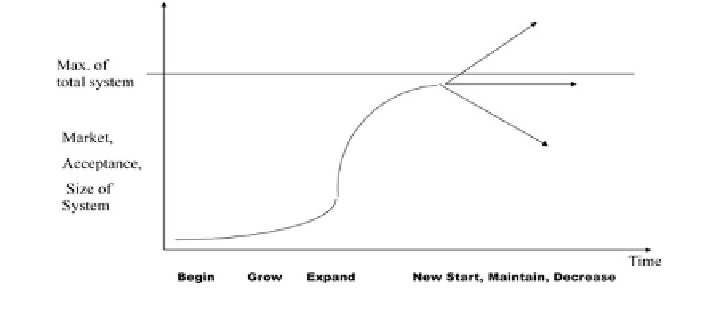Civil Engineering Reference
In-Depth Information
Fig. 2
Life cycle of innovation cluster. Source Yim (
2008
)
Sweden are the ones created by government. And it is obvious that such innovation
clusters are leading their national competitiveness.
The innovation cluster has a life cycle, which means it is borne but also can die
away as the environment changes. The developing stage of a cluster can be
classified as Pre-cluster, Emerging-cluster, Expanding-cluster, and Restructuring-
cluster. First, Pre-cluster stage stands for a period that few firms have very limited
links among them. There is little economic impact and Anchor companies emerge.
Second, in Emerging-cluster stage, firms create links and organize among them-
selves to form industry associations and alliances. Third, in Expanding-cluster
period, linkages and critical mass grow and the economic impact is expanded.
Fourth, under Restructuring-cluster stage, there are high inter-firm links. Moreover
cluster spawns new clusters and begins to adapt in changing market (Sadik
2001
).
The life cycle of an innovation cluster can be drawn using time, market vari-
ables. Typical pattern of growth is that it takes a shape of exponential growth.
Normally, it takes a long period of time to reach a certain tipping point for the
exponential growth. However, when it reach the saturation point where the
innovation cluster meet the maximum capacity of total system, it either grow
again, or remain at the same level, or die away Fig.
2
.
For the development paths of an innovation cluster, Yim (
2002
) has concep-
tualized two different paths, in the context of value chain process. The growth of
innovation cluster can be classified into two subcategories of clustering. One is
''downstream clustering'' where, the high science and technology level leads and
expands to production and market. The other ''upstream clustering,'' where the
strong basis of the marketing capability or production capability leads to the R&D
function at the end. One example of the first type is ''Silicon Valley'' and that of
the second type is ''Dongdaemun market (Korea)'' driven to subcontract produc-
tion in the beginning, then with the emergence of shopping centers, synergy effects
were generated from interactions between market and productive function which
finally leads to the development of design (R&D) function Fig.
3
.

Search WWH ::

Custom Search